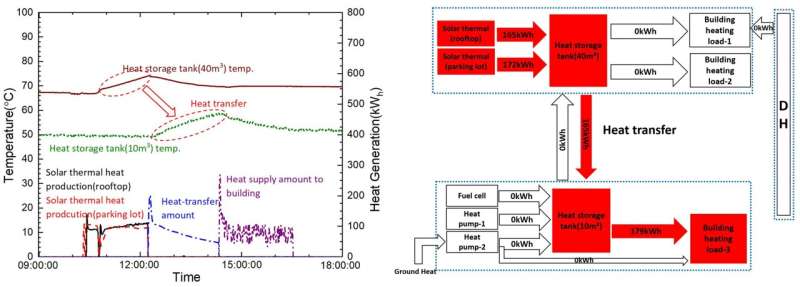Photo of demonstration facility. Credit: Korea Institute of Civil Engineering and Building Technology
Global energy trends are shifting toward digitalization, decarbonization and decentralization. Global warming and climate anomalies attributable to environmental pollution featured in the daily news indicate that the threats of climate change are no longer far-fetched. According to a report published by the Intergovernmental Panel on Climate Change (IPCC), carbon emissions from urban areas in 2020 accounted for 67% to 72% of the total emissions. Globally, efforts are being made to reduce carbon emissions from urban areas and buildings through provision of renewable energy and construction of zero-energy buildings.
A research team at the Department of Building Energy Research of the Korea Institute of Civil Engineering and Building Technology (KICT, President Kim Byung-suk), has developed a bi-directional heat trade system that utilizes excess heat from renewable energy including solar heat in an effort to achieve carbon neutrality in buildings.
Solar heat, geothermal heat, and fuel cells are increasingly used either individually or together in hybrid systems to reduce the heating and cooling energy used in buildings. However, such systems are likely to produce excess heat due to mismatch between the building's heat demand and the renewable-based heat supply. Excess heat, or waste heat, is heat that is not used after intermittent heat production.
For example, during the spring in Korea when solar radiation is adequate, sufficient heat can be generated. However, the season does not require a high level of heating, thereby leading to waste of some of the heat. The research team, led by Research Fellow Yongki Kim, developed a system that helps buildings trade the excess heat bi-directionally via heating pipes after self-consumption in areas where there are high concentrations of buildings.
Photo of heat piping network. Credit: Korea Institute of Civil Engineering and Building Technology
The team configured a network of heating pipes for the three buildings of the KICT located in Ilsan, Korea and used an array of solar and geothermal heat and fuel cells as the sources of heat. Two 944 m2 solar thermal collectors were installed in the outdoor parking lot and on the rooftop, and a heat pump for a 310kWth geo-thermal heat source, a 10kWp fuel-cell system and two thermal storage facilities of 40 m3 and 10 m3 capacities were built.
The simulation and the proof of concept proved that the twin pipe is effective in the network of low-temperature heat pipes with about 10% heat loss. When there is enough sunlight, hot water for heating is supplied by solar heat to the secondary pipe of district heating through a heat exchanger. When there is insufficient sunlight, hot water can be supplied through the heat pump system of the geothermal source and the fuel-cell system. The bi-directional heat trade system can be controlled both manually and automatically at the integrated control center.
Renewable heat energy applied to a building is usually for self-consumption. In a small-scale district heating system, supply and demand facilities are separated and heat is supplied unidirectionally. In this study, the bi-directional heat trade system was implemented, improving the utilization rate of renewable heat source facilities and system efficiency.
Experimental results of daily heat trade. Credit: Korea Institute of Civil Engineering and Building Technology
Yongki Kim, the head of the research team said, "The system has potential to increase the use of renewable heat energy in cities and buildings, which will ultimately reduce their carbon emissions."
More information: Muhammad Usman et al, Pipe Insulation Evaluation for Low-Temperature District Heating Implementation in South Korea, Frontiers in Energy Research (2022). DOI: 10.3389/fenrg.2021.793557
Provided by National Research Council of Science & Technology


























